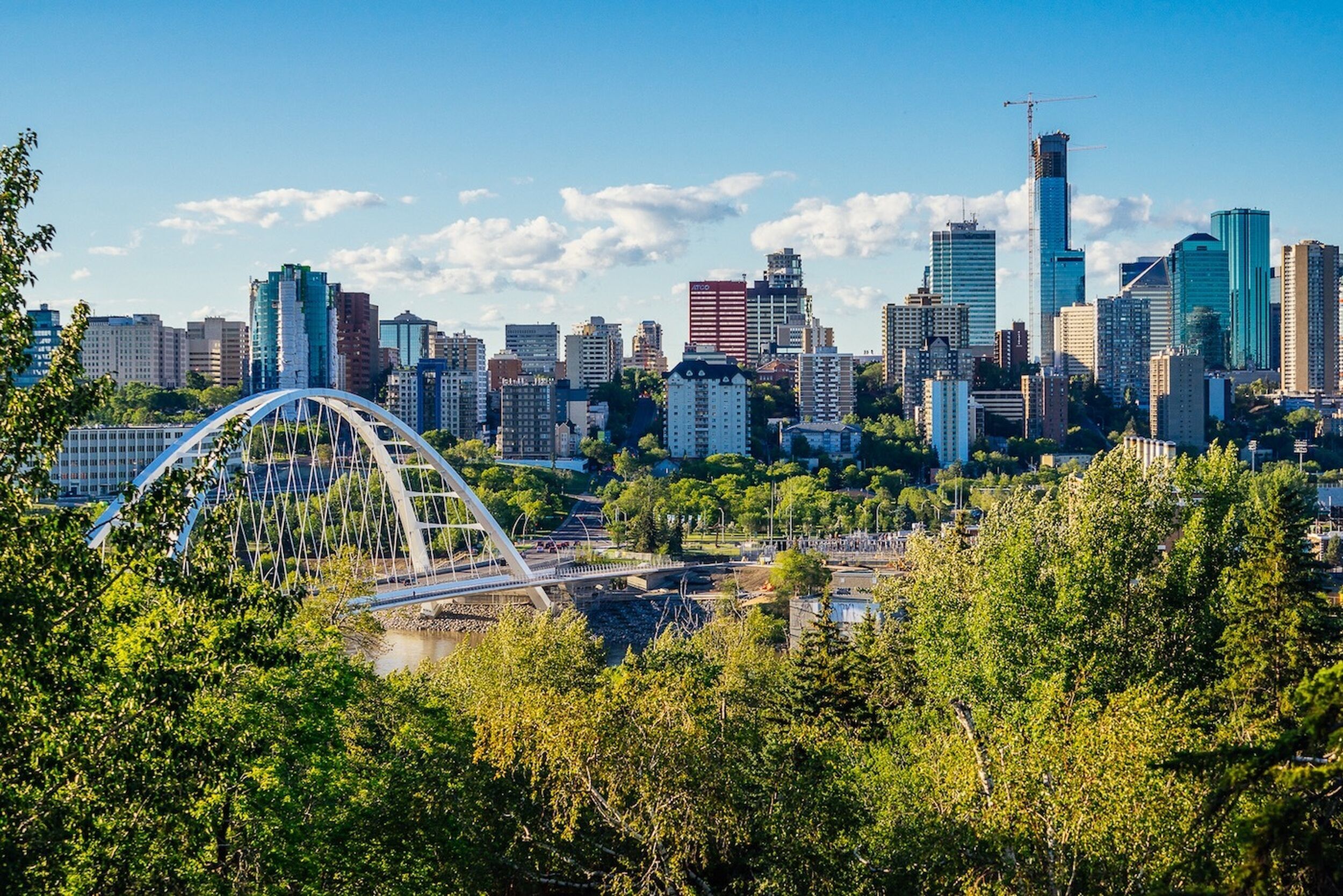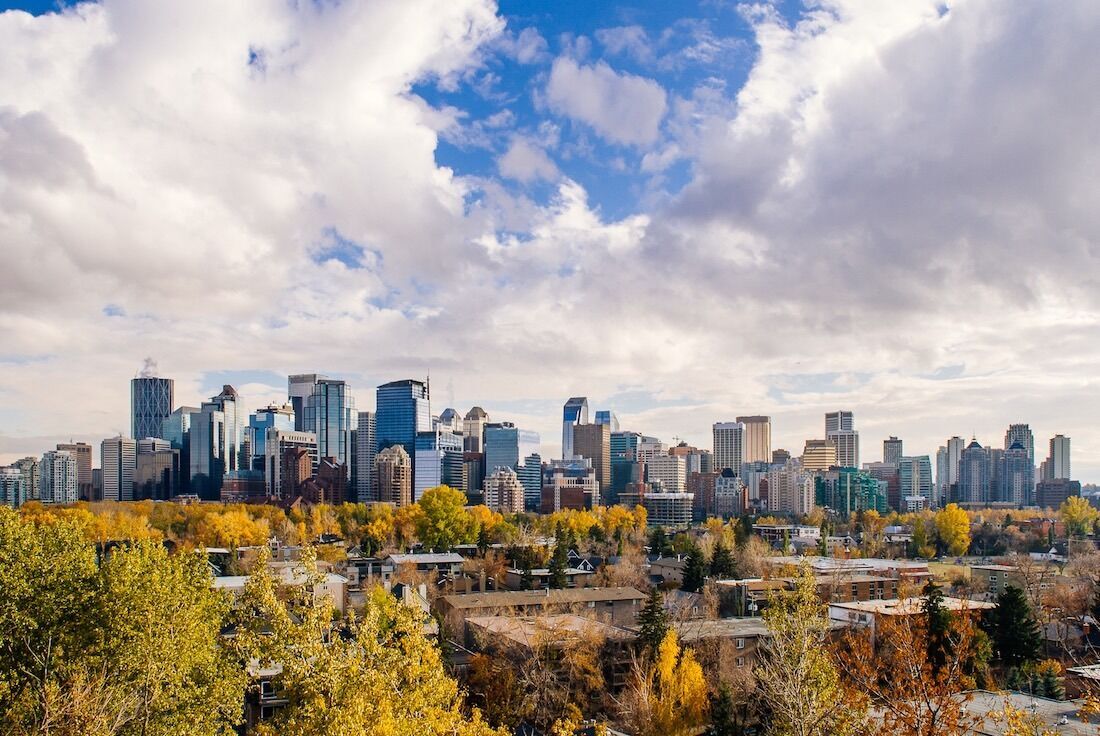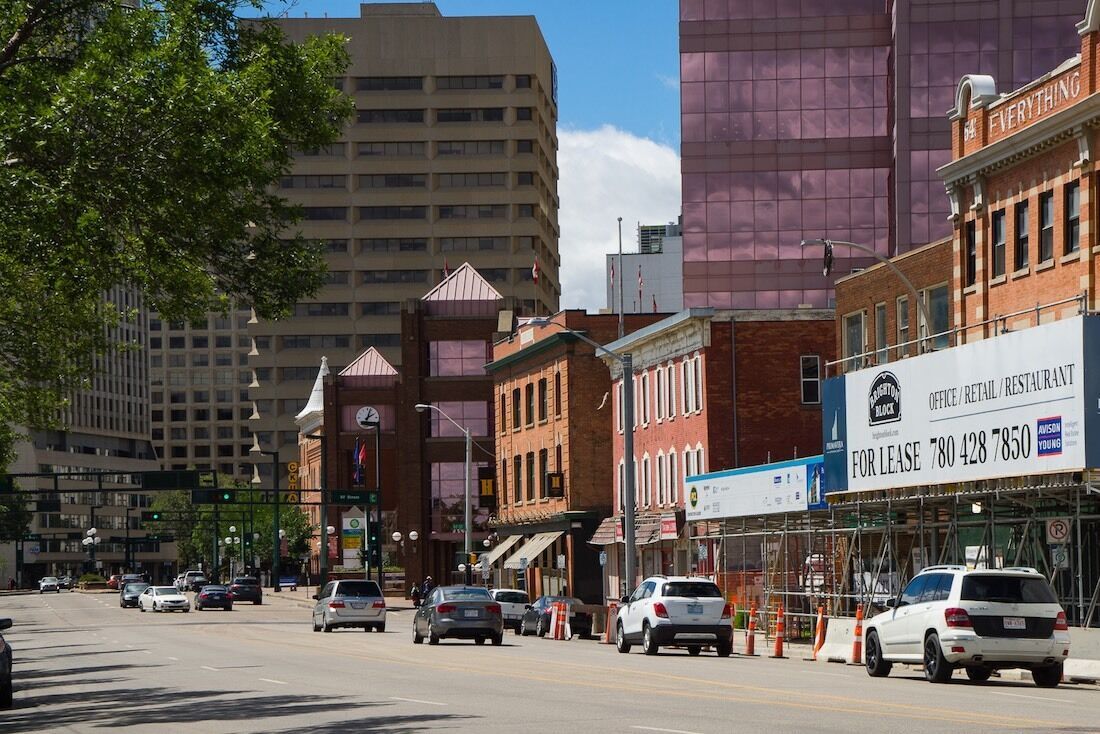
Without a city charter, Edmonton has small-town status under the province. Photo: Rob Moses
Michael Walters had to wait for councillors from Blackfalds, Penhold and Ponoka before he finally got the mic.
“Will permanent, supportive housing be a key solution to urban homelessness for this government?” he asked. “Will you work with us to build it?”
It was late September and Walters, a city councillor in Edmonton, was putting the question to a group of UCP ministers at the Alberta Urban Municipalities Association convention.
Outside, the federal election campaign was raging, but inside, hundreds of reeves, councillors and mayors wanted to ask about the looming UCP budget.
Walters represents a city with 1 million people and megaprojects that match its size. Blackfalds has less than 10,000 people. But whether you spoke for Blackfalds, or Ranchland No. 66 (population: 92), or Calgary, you got 45 seconds.
It’s absurd, yet each municipality is, technically, equally subservient to the Alberta government. Thank the rural-biased Canadian constitution for that.
The answer to Walters’ question came, definitively, in October, with the UCP budget. The budget announced a ‘no’ to partnerships and an end to the big city charters signed by Alberta with Calgary and Edmonton in 2018.
Indeed, rather than recognize that Calgary and Edmonton face an entirely different scale of challenge, the budget flattens them back into subservience with towns, villages and hamlets.

The UCP budget is more than just cuts. It accelerates the download of costs and responsibilities onto Alberta’s largest cities—and, to be clear, this means just two, as Edmonton is about eight times larger than the next largest, Red Deer.
It's a budget of indifference to our growing, and vital, metropolitan economies.
Ripped-up city charters were made for a reason
Edmonton and Calgary have sought city charters since the 1980s, and the ideas even stretch back to the late ‘50s and the McNally Commission, which recognized Calgary and Edmonton had become rapid growth magnets. It also limited commuter cities (think Mississauga beside Toronto) from sprouting up.
Why charters? In the ‘80s, and in Alberta’s case the Ralph Klein ‘90s, governments in the West cut the welfare state and big cities bore the brunt. Affordable housing, for example, should be federal and provincial concerns but, well, aren’t.
At the same time, both Calgary and Edmonton experienced endless population booms. In 1985, Calgary had roughly 630,000 people, and Edmonton had about 565,000. Both have now doubled.
Today, these two cities are home to half of Alberta’s 4.3-million people. Combined, they create a yearly GDP that’s roughly two-thirds of Alberta’s overall GDP of $335 billion.
As our big-city economies boom, so does Alberta’s.
The main tool cities have to raise money is a dud: property taxes.
Trouble is, the main tool these cities have to raise money is a dud: property taxes.
In a nutshell, property taxes are an owner’s share of a municipality’s budget, based on an assessment of property value. If a city’s budget goes up, property tax goes up—roughly a one to one relationship.
What property taxes don’t relate to so well is the economy.
If your city’s average income doubles, or its investments create a tourism boom, or half your downtown workforce drives in from outside property-tax limits (looking at you, Sherwood Park), Alberta and Ottawa can collect more income tax—but your city could still have the same property tax base while its costs significantly increase.
For big cities, Calgary Mayor Nenshi says property taxes are insufficient and the charters were an attempt to fix that.
“We finally, after decades of asking, were able to replace the way that we get provincial capital funding,” Nenshi said.

A 'giant step backward'
The shift, Nenshi explains, was from “episodic and ad hoc” capital money to a straight revenue share.
Because the charters indexed capital money to Alberta revenues, both Calgary and Edmonton had agreed to a 40% cut (due to Alberta’s depressed oil and gas revenues) in exchange for certainty.
With the UCP budget, the charters are now gone but that 40% cut remains — plus an additional 9% cut to Municipal Sustainability Initiative (MSI) funding, which goes toward infrastructure.
The budget is especially unfair to big cities, Nenshi told CBC after the budget came down.
"Despite our desperate needs for roads, bridges, and social infrastructure, we're being singled out to take a much larger cut than every other municipality in the province,” he said.
When we limit our cities, we’re basically limiting our ability to develop a more diversified economy.
The big-city stuff faces the biggest threats—the Green Line in Calgary and the Valley Line West extension in Edmonton. Both are, technically, still to receive about a third of their cost from Alberta, but the funding has been pushed back and Alberta has given itself the right to give just 90-days-notice if it feels like bailing.
Byron Miller, a professor of urban studies at the University of Calgary, says scrapping the charters is a “giant step backward” because it limits the entire province’s fortunes.
“When we limit our cities, we’re basically limiting our ability to develop a more diversified economy,” he said.
Opening the door to more sprawl—and its high costs
Walters, the Edmonton councillor, says he agrees with UCP rhetoric that big cities can spend less. What concerns him, though, is the specific cuts to LRT and universities, which could hurt diversification and innovation.
Beyond that, Walters is especially concerned that the UCP’s red-tape changes could see Calgary and Edmonton lose the ability to develop regional growth plans and, in turn, better suburbs at their edges.
Walters recently blogged about Edmonton’s costs, noting the city is 44-times less dense than Vancouver, and that it can’t afford to continue like this in future.
Yet it might.
Land use and urban form affect our ability to keep our fiscal house in order.
“If [the UCP] take away those tools under the guise of red tape reduction, they’re allowing the proliferation of lower density suburban communities,” he said. “They’re the single biggest driver of costs.”
It’s a point Calgary is also grappling with.
Earlier this month, a council committee heard that council's 2018 decision to approve 14 new greenfield communities will create a $56.9 million shortfall over three years.
“We’re going to see service cuts to fully built-out neighbourhoods across the city while we’re building new infrastructure in places that people [don’t live],” Councillor Evan Woolley said, as quoted in the Calgary Herald.
Without power and cash, cities will struggle
The UCP didn’t offer big cities new ways to raise money. Given the province’s overlord status with cities, it can and should.
Research shows that a 1% municipal surtax, for example, could raise $28.6 million in Calgary and $17.8 million in Edmonton. A city sales tax could raise up to $200 million in Calgary and $125 million in Edmonton. And just imagine giving cities road tolls.
Without that power and cash, building a city will be bloody difficult. For example, will Calgary’s Green Line be built?
“It has to be built and it will be built,” Nenshi said, when I put the question to him. “The core question is when will it be built and what will it look like? It’s not a frivolous thing. It’s absolutely required for us to manage congestion.”
[The Green Line] is absolutely required for us to manage congestion.
The same response is likely for any infrastructure investment in Calgary or Edmonton threatened by the UCP budget. The two cities are growing faster than any other big cities in Canada (though the UCP has pointed out spending has grown faster than population).
Walters notes that Alberta's new approach to cities could contradict the UCP's narrative of efficiency and belt-tightening.
“We’ve got to figure out a way to create a deeper understanding of the importance of cities to the provincial economy, and how land use and urban form affect our ability to keep our fiscal house in order,” he said.
From rural identity to an urban one
But perhaps most interesting is what it all could mean over time: A shift in how we think of ourselves as Albertans.
“We have this ideology that we live in a rural province,” Miller said (and it’s here we should note the UCP dominates in rural ridings, where Albertans have not elected a non-conservative since 1993).
But if the UCP’s strategy to bring back oil booms and rely on royalties to pay for big-city infrastructure fails—which Miller expects it will—the country nostalgia will start to feel old.
There’s a real disconnect between the policies and the ways the world is changing.
Eight in 10 of us already live in an urban area. The crash of the old economy might make us wake up to that.
“I think the UCP will pay a hefty price for this,” Miller said. “There’s a real disconnect between the policies and the ways the world is changing.”
Alberta Minister of Municipal Affairs Kaycee Madu was contacted for this story but did not agree to an interview.
Tim Querengesser is a writer in Edmonton. He has written about cities for CityLab, Canadian Geographic and the Globe and Mail.
The Sprawl relies on people who pitch in a few dollars a month to support independent Alberta journalism. Please become a Sprawl member so we can keep at it!
Support in-depth Calgary journalism.
Sign Me Up!We connect Calgarians with their city through in-depth, curiosity-driven journalism—but can't do this alone! We rely on our readers and listeners to fund our work. Join us by becoming a Sprawl member today!
